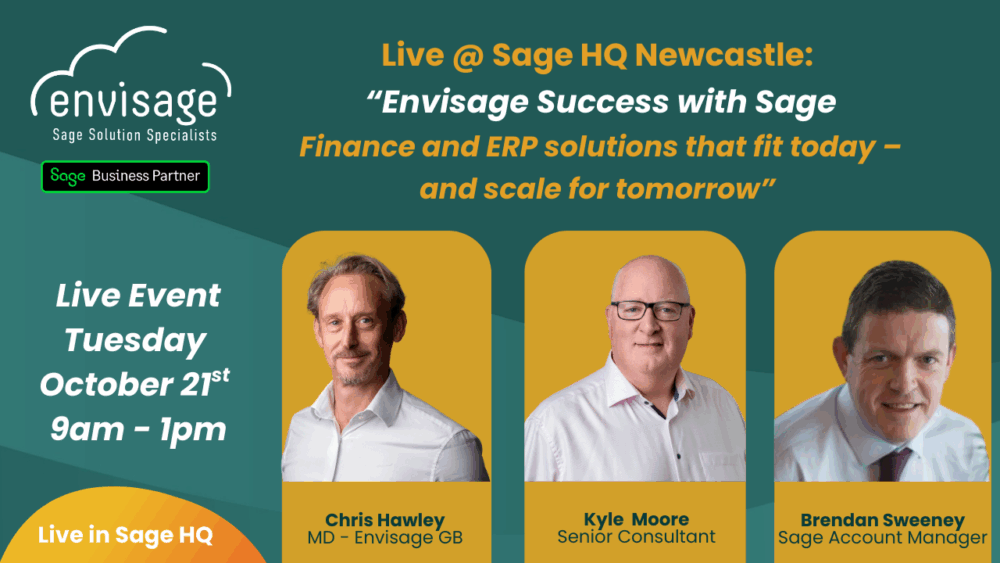
- Education, Sage, Sage 200
Sage has rolled out the 2025 R1 update for Sage 200 Standard, Sage 200 Professional, and Sage for Education – a release shaped by customer feedback to help organisations stay on top of increasingly complex financial demands.
This update arrives at a time when finance teams are under growing pressure to improve efficiency with limited resources. The enhancements introduced in this version focus on real-world usability, improved compliance, communication tools, stock management, and integration – all designed to support better decision-making and more responsive operations.
At Envisage, we support UK businesses and educational institutions in getting the most out of Sage’s financial management software. Here’s a closer look at what this release delivers and how it could benefit your organisation.
Key improvements in Sage 200 2025 R1: Smarter Sage solutions for small businesses
Sage 200’s latest release is built around three major priorities: usability, visibility, and compliance. These updates aim to help small and medium-sized businesses streamline operations, improve accuracy, and respond more effectively to internal and external demands.
1. Stock item alerts – instant visibility where it matters
Inventory can be a challenge for growing businesses. The new stock item alerts feature extends Sage’s existing alert functionality into the stock module, offering timely notifications directly within workflows such as sales orders, purchase orders, and invoicing.
Whether it’s flagging low stock levels, urgent handling notes, or important deadlines, the new alerts make it easier for teams to stay informed and act fast – without the need for manual checks or switching between systems.
2. Smarter customer and supplier communication tracking
Effective communication supports financial control. With the new communication tracking feature, teams can log and access all interactions with customers and suppliers from a single location.
This provides greater visibility for credit control and finance teams, enabling quicker resolutions, more cohesive service, and better relationship management. In turn, it supports healthier cash flow and more coordinated operations.
3. Country-of-origin field for stock items
A long-awaited enhancement, the country-of-origin field is now part of the standard stock listing. For businesses importing goods or operating under sector-specific regulations, this simplifies compliance and reporting processes.
It’s especially useful for organisations needing to meet customs requirements or conduct supplier audits – giving instant access to vital product data without extra admin.
A more modern experience with enhanced Sage ERP solutions
The 2025 R1 update brings visual and functional improvements to the Sage 200 interface, with a focus on simplifying processes for hybrid and remote teams. Newly available commercial web screens include:
• SOP Returns (Enter, Amend, View)
• SOP Amend Order Status
• Amend Return Status
These updates offer a more flexible experience for users managing sales operations and returns, whether on-site or working remotely. Additionally, API enhancements allow for smoother integration with external platforms and bespoke tools – supporting greater automation and interoperability.
Keeping ahead of compliance: SEPA EBanking updates
Staying compliant with banking regulations is critical, especially as financial rules evolve. The 2025 R1 update introduces SEPA-related changes to Sage’s EBanking functionality, helping businesses process payments securely across Europe.
Key updates include:
• System-wide adjustments to meet SEPA standards
• Two new EBanking plugins to support various banking requirements
These changes ensure your financial management software continues to operate in line with regulatory expectations, reducing manual interventions and ensuring secure transaction processing.
What’s new in Sage for Education 2025 R1?
Educational institutions face unique financial challenges – from departmental budgets to complex compliance requirements. The Sage for Education version of this release incorporates all the core Sage 200 improvements, with added features designed specifically for schools, colleges, and universities.
This includes tools for tracking funding, managing multiple cost centres, and ensuring transparent engagement with key stakeholders. The 2025 R1 release helps education providers remain agile and accountable in a changing regulatory environment.
Is it time for a Sage 50 upgrade? Transitioning from Sage 50 to Sage 200
If your organisation has outgrown Sage 50, now is an ideal moment to consider an upgrade. The new features in Sage 200 2025 R1 offer a compelling step forward for companies managing more complex operations or compliance needs.
A Sage 50 upgrade opens the door to:
• Advanced inventory and order workflows
• Real-time visibility across departments and sites
• Enhanced financial forecasting and reporting
• Integration with cloud-based platforms and tools
• More robust compliance and audit controls
At Envisage, we’ve supported many UK organisations through this transition. If you’re considering a Sage 50 upgrade, our team is ready to help you plan and implement the change with minimal disruption.
Supporting growth, together
From multi-site companies to educational institutions, financial agility has never been more important. At Envisage, we partner with organisations across the UK to implement smart, scalable financial management software solutions using Sage 200.
If you’re considering the 2025 R1 update or ready to take the next step beyond Sage 50, we’d love to explore how we can support your goals.
Email us at sales@envisagecloud.ie or use our online contact form to start the conversation.
About the Author

Steve Boyes
Steve Boyes, the COO at Envisage, brings over 20 years of experience in accounting and IT to the table. With a robust background in specifying, designing, implementing, and supporting strategic solutions for SMEs, public sector, and not-for-profit organisations, Steve excels in addressing clients' real business problems and requirements rather than just focusing on technology. His approach has led to the successful execution of projects with some of Ireland's best-known companies.






